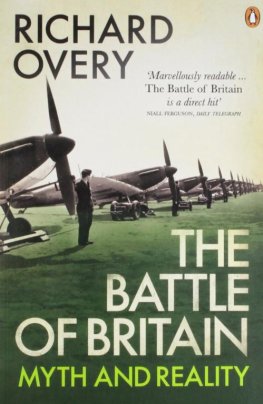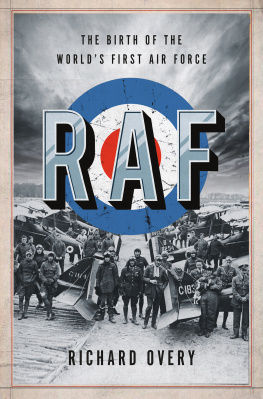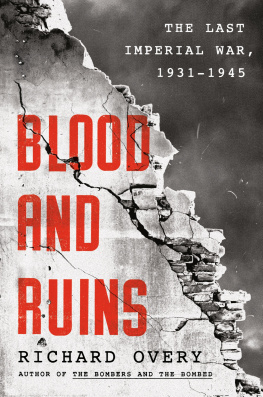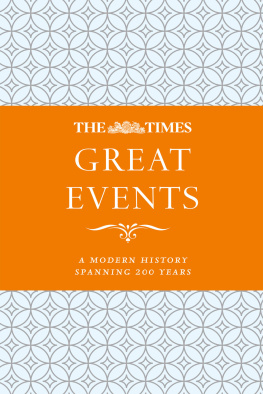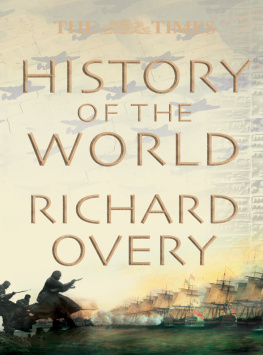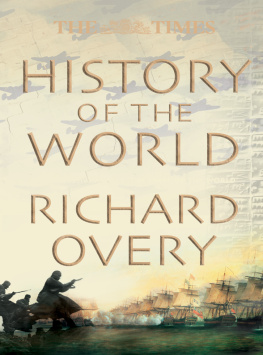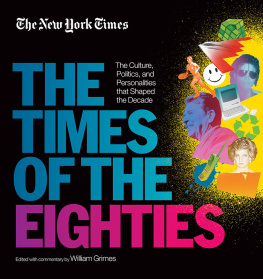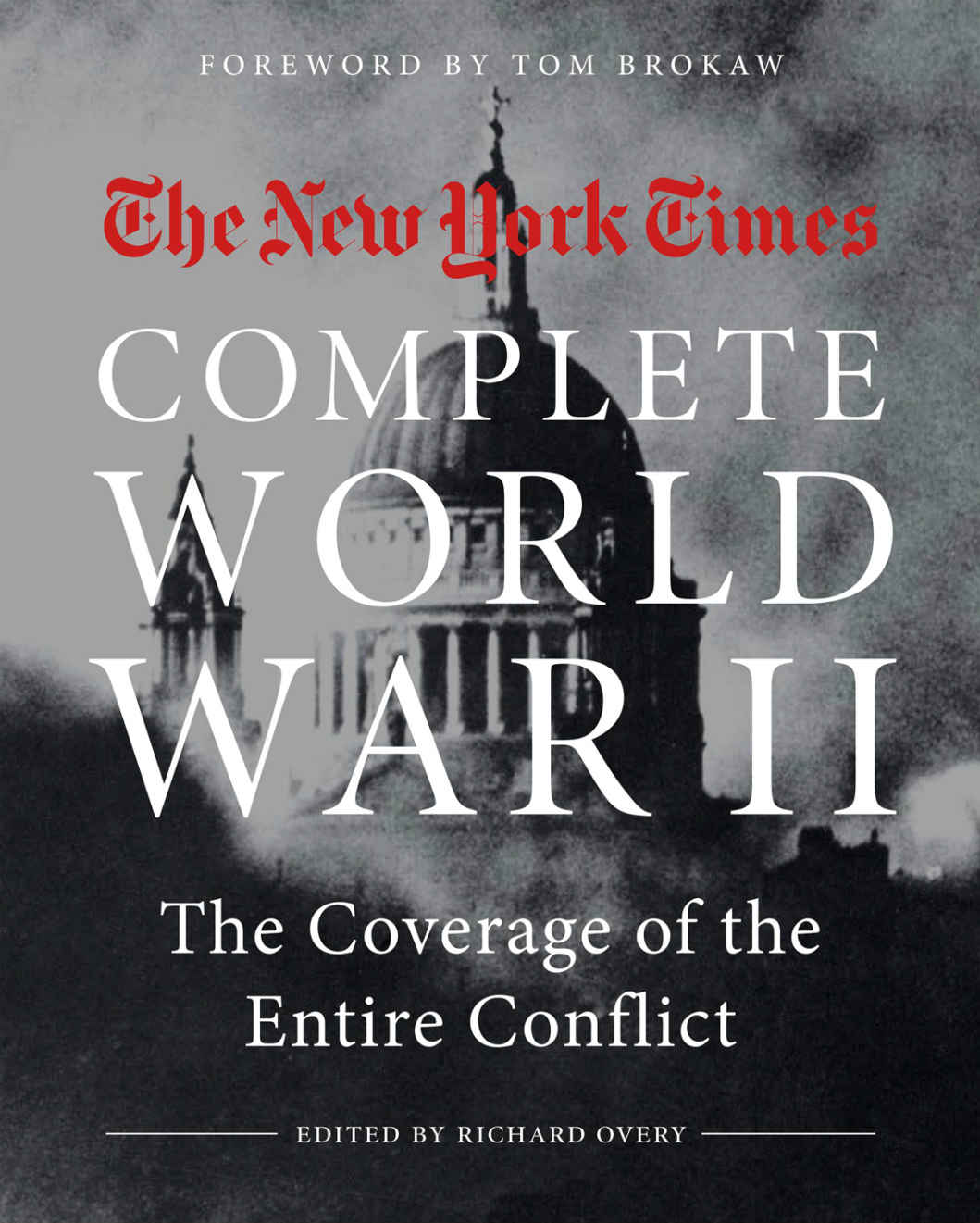Hachette Book Group supports the right to free expression and the value of copyright. The purpose of copyright is to encourage writers and artists to produce the creative works that enrich our culture.
The scanning, uploading, and distribution of this book without permission is a theft of the authors intellectual property. If you would like permission to use material from the book (other than for review purposes), please contact permissions@hbgusa.com. Thank you for your support of the authors rights.
Foreword
By Tom Brokaw
A hundred years from now, five hundred, a thousand, historians will be studying World War II and wondering, How did it come to this? This madness of all out war in the heart of Western civilization and across the vast Pacific ocean, a war so lethal and so ambitious it would be described by John Keegan, the noted British military historian, as the greatest event in the history of mankind.
As you will see in these dispatches from reporters from The New York Times at home and abroadfrom 1939 to the end of the war in 1945it was at the beginning a confusing, complex time of duplicity, denial, wishful thinking. Adolf Hitler aroused Germany with maniacal fervor and Japan began to plant its flag well beyond its small island boundaries.
Germany invades Poland and on September 1, 1939, The Times reported in bold print WASHINGTON VIEWS THE CRISIS GRAVELY, describing how President Franklin D. Roosevelt spent the day reading press dispatches and listening to radio broadcasts from Europe. The following day France mobilizes eight million for military duty and the day after that Great Britain declares war on Germany.
Yet on September 3 Harold B. Hinton of The New York Times publishes a long, analytical piece headlined, CAN THE UNITED STATES KEEP OUT OF WAR? He describes President Roosevelts apprehensions about Hitler and his subtle preparations for war but he quotes the President as saying he hoped and believed the country could stay clear and his Administration would do all it could to keep it out of war.
That is how it began, this greatest event in the history of mankind, with ominous German overtures, alarmed European reaction and now you see it, now you dont denial from Americas commander in chief.
From that date forward the reporters and editors of The New York Times were in a quick step march to keep pace with the unfolding events.
Canada and Australia, British Commonwealth countries, jump in; James Reston in London for The Times describes a city hunkered down against German air raids and then later chronicles the rise of Winston Churchill. In prescient terms: War is Mr. Churchills natural element. Like a happy old tugboat captain with a battered sailors cap on his head and a dead cigar between his teeth he has looked and sounded like s real war leader.
And so he was.
The news kept on coming, from East and West:
BRITISH CHILDREN EVACUATED FROM CITIES
FABLED RUSSIAN WINTER CLOSING IN ON INVADER
SINGAPORE DOUBTS JAPANESE THREATS
U-BOAT SINKS BRITISH BATTLESHIP
Charles Lindbergh continues to speak out against the United States getting involved in the war and American mothers of sons storm Congress, demanding the U.S. not get involved .
But by the fall of 1941 FDRs private concerns have turned into a roaring war weapons program he calls The Arsenal of Democracy and Hanson Baldwin writes in The Times the Arsenal of Democracy has commenced to bristle with arms.
A month and a week later, December 7, 1941, the United States is stunned, attacked on a sunny Sunday morning at Pearl Harbor by the Japanese. It is, as FDR would tell the world, a day that will live in infamy, a day that catapulted the United States into the war.
In the last great naval battles of modern history, the U.S. and Japan fight across the Pacific and on the tiny islands no one had heard of beforeTarawa, Iwo Jima, GuadalcanalAmerican and Japanese fight hand to hand, face to face in utter savagery.
A World War unlike any other. In North Africa, Italy, throughout Europe and in western Russian, in all the seas and the skies above.
Sixteen million Americans are in uniform doing everything from penetrating deep behind enemy lines to baking bread and packing parachutes, from jumping out of airplanes and taking submarines to great depths.
Russia advances from the east. Allied forces gather in England for the greatest military invasion ever under the command of a genial Kansas farm boy who had been a colonel as late as 1941.
D-Day, June 6, 1944, the emblematic battle of the war. It was a massive sea, air and land operation and it was the beginning of the end of the Third Reich and the madness of Adolf Hitler.
Yet, news of the invasion didnt reach New York Times reporters and other journalists in Washington until three hours after it began.
From that day on the news began to be more hopeful. Headlines in The Times:
NAZIS CONTINUE TO GUESS ABOUT GENERAL PATTONS ARMY
JAPANESE CRUSHED (in Saipan)
B-29s MAKE THEIR DEBUT
RED ARMY DRIVE SHOWS NO SIGN OF FLAGGING
Caught in the pincers of Russia advancing from the east and the Allies from the West, the Germans fight on but the wounds are fatal. Adolf Hitler, historys despot, puts a gun to his head in a Berlin bunker, his malignant dreams of a thousand-year empire, at an end in less than a decade.
In the Pacific, the Allied spear is now pointed at the Japanese homeland, an invasion that no one welcomes but unless the Japanese surrender, it cannot be avoided.
But it is, called off by the devastating impact of two bombs, new weapons created out of the terrifying effect of nuclear fusion.
The madness ends in August 1945. A world war in every sense of the phrase gives way to a difficult peace with unprecedented re-building and re-alignment required, with a new kind of war, a Cold War between the Soviet Union and the West, with the creation of a new nation in the Middle East as a partial tribute to the horrors of the Holocaust.
An uneasy peace, but a welcome one. Men came home to go to college or go to work in a peacetime economy that had been dormant too long. Women gave birth to a new generation with its own distinctive title. Detroit began to build civilian cars again. Meat was available in the supermarkets, and butter. New cities arose in the southeast, southwest and west.
Those who had borne the battle left the terrible memories deep in an emotional vault and got on with their lives, determined to make up for all they and their families and friends had sacrificed.
In these reports from The New York Times you can trace the origins of that chaotic time, share in the momentous decision making, be inspired by the greatness of the leaders of the victors and enraged by the mendacity of the war mongers.
This is timeless journalism and a gift to those of us who lived through it and those who want to know historys great question: how did this happen, and how did we prevail.


